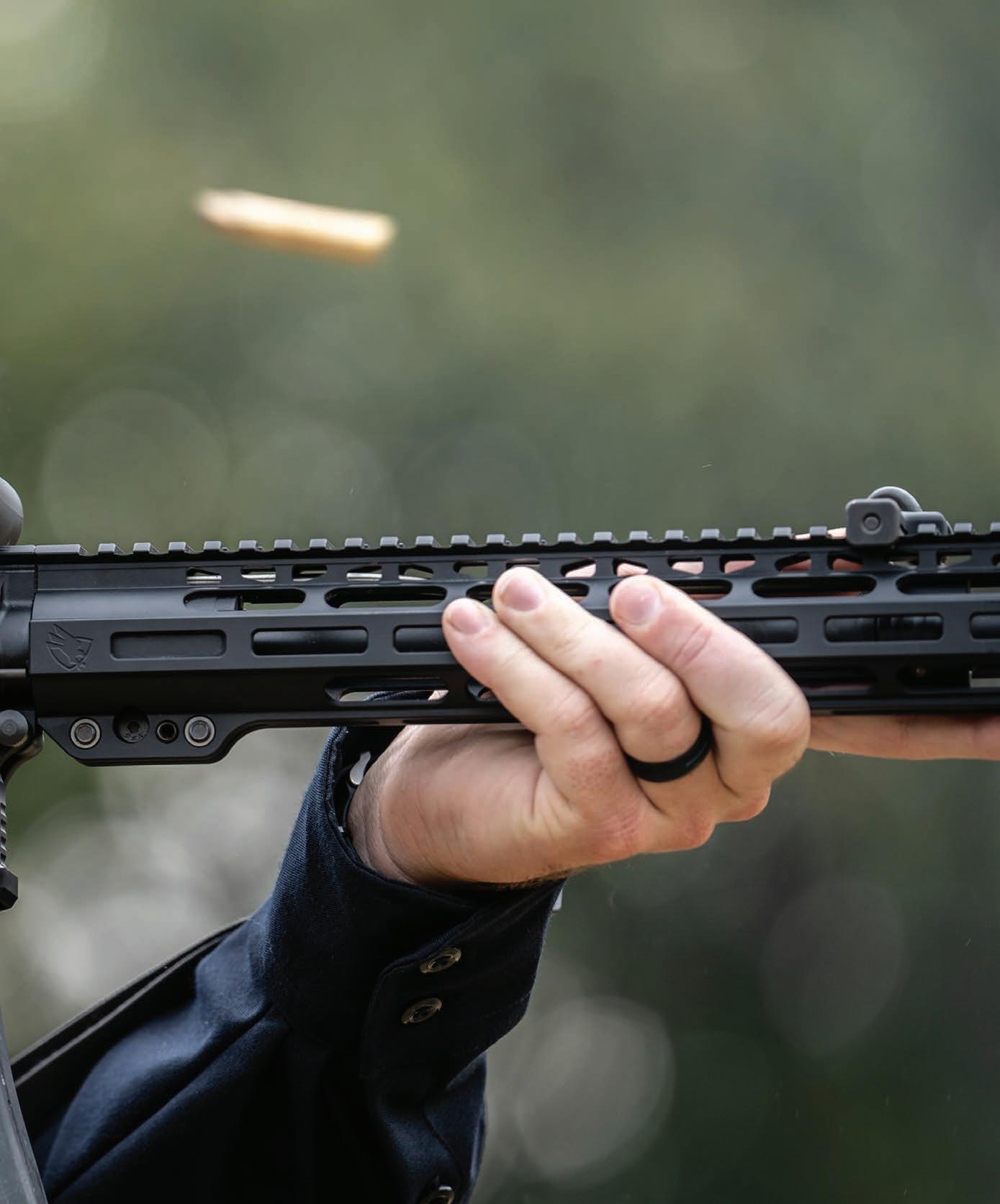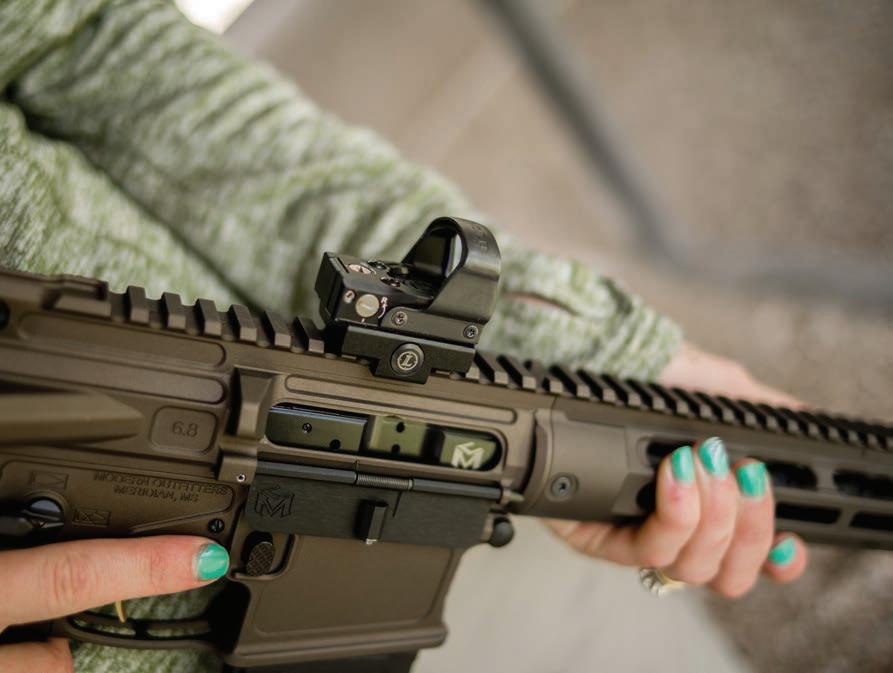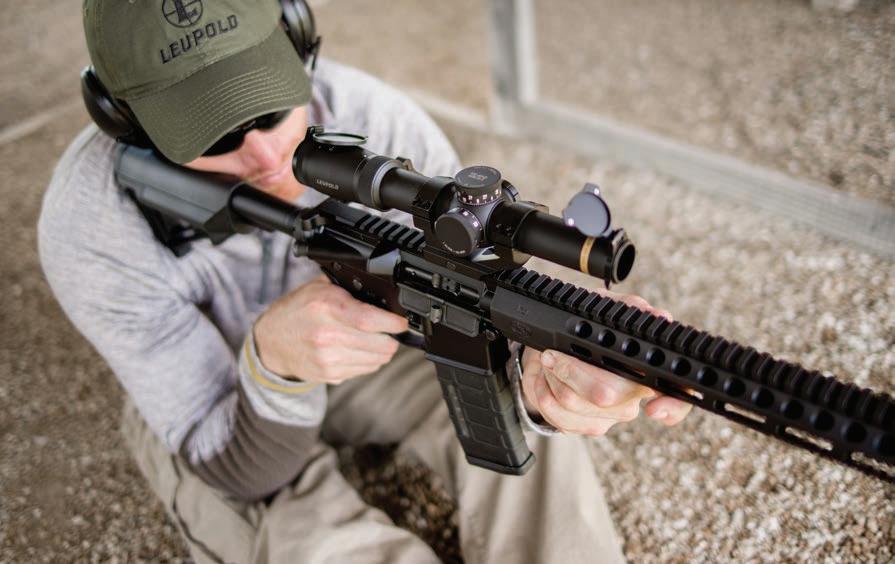
9 minute read
SELLING AR OPTICS
SELLING AR
by Robert Sadowski
OPTICS
A bewildering array of choices can cause sensory overload. The job of the retailer is to narrow down those choices to a manageable handful.
Your customer just chose an AR rifle, and if it is like most ARs sold today, it is optic-ready. That doesn’t mean the AR is equipped with an optic, only that it can accommodate an

optic. The best way to help them choose an appropriate optic is to ask them what they intend to use the AR for— self-defense, hunting, or competition. The answer will help you better narrow down the type of optic that would serve them best: dot-style (reflex) sights, prism sight/scopes, variable-power riflescopes, or digital hybrids. All of these AR optics have pros and cons, so let’s look at which is best suited for your customer.
IRON SIGHTS
The AR rifle was designed to be fired using iron sights. The fixed A2-style front sight, which was originally standard equipment on military-issued M16 rifles circa the early 1960s, still has a following today. While the AR carry handle, which housed the rear sight, was original equipment, modern ARs have evolved to a flat-top receiver equipped with a Picatinny rail. This modern upper receiver is by far the most popular choice with users because it offers the ability to easily mount a variety of optic types.
That said, there are advantages to iron sights. If the optic is damaged, iron sights offer a backup, which can mean the difference between aiming an AR versus pointing an AR when the optic goes sideways. Back Up Iron Sights (BUIS) are designed to fold flat and flip-up when the optic goes down. The drawback of iron sights used in conjunction with optics is that iron sights tend to block some of the field of view. At close range that is really not a problem, but at distance, the user will find that the sight picture becomes cluttered.
DOT-STYLE REFLEX SIGHTS
Reflex sights, also known as dot sights or red dots, use a dot reticle that the user places on the target to take the shot. Dot-style reflex sights have an edge in close-quarter situations because the dot is easy to focus on. Reflex sights also offer fast target acquisition and are best suited for defense work. Depending on the type of hunting the customer may do, say hunting pigs from a blind at under 75 yards, a dot sight excels. Reflex sights have no magnification, but offer unlimited eye relief; in many respects they are similar to iron sights but are far easier to use because you only focus on the dot—you don’t have to align a rear and front sight. Most quality reflex sights are also parallex-free and offer consistent sighting. Better reflex sights offer automatic dot brightness adjustment, depending on the lighting in the environment. In my opinion, this allows the user to focus on the target instead of fussing with the sight.
Reflex sights are compact, lightweight, and have a small footprint, so they don’t add extra weight or bulk to the rifle. They are powered by readily available batteries that can be bought at convenience stores or gas stations. Premium reflex sights have features built in to conserve battery life. Some models turn off after inactivity and turn immediately on when picked up. I have had sights that sip battery juice and last for years.
Reflex sights pair well with backup iron sights; the iron sights co-witness with the dot, so you are always ready even if your dot sight batteries are DOA.
Dot reticles come in a variety of sizes and colors. We tend to call all dot-style sights red-dot sights because these sights were originally designed with a red dot. Today there are green-dot reticles as well as some that are blue. I suggest you have your customer view different color dot sights side by side. (Note: in this instance you need to ask if the customer is color blind.) Let them choose the color that best works with their eyes. Dot sizes typically are 2 MOA, 3.5 MOA, and 4 MOA. Small reticles are easier to use at farther distances, large dots tend to obscure the target at farther distances. At close range large dots offer fast target acquisition. Some reflex sights offer BDC-style reticles with holdover points for long-range shooting.
Most reflex sights come with a Picatinny mount, so installation is fast and easy.
Reflex sights tend to be the least expensive option for an AR optic. Premium-brand dot sights include the Aimpoint ACPRO P-1 or Duty RDS (Booth #13007), Trijicon MRO HD (Booth #10735), and EOTECH 5x Series (Booth #20049). These sights are street- and battle-tested. A good mid-range reflex sight is the Holosun AEMS (Booth #13420). Affordable red dots include Crimson Trace HRO (Booth #12805) or Bushnell TRS-125 (Booth #11838).

PRISM RIFLESCOPES
Think of a prism riflescope as a step between a dot-style reflex sight and a variable-power riflescope. Prism riflescopes combine a dot-style reticle of a reflex sight with the magnification of a variable-power riflescope.
Traditional riflescopes use a series of lenses to focus on a target. A prism scope uses a glass prism to focus on the target. Prism scopes are more compact than a traditional scope yet have many of the same features such as magnification, an illuminated etched reticle, and a focusing eyepiece.
Compared to a reflex sight, a prism scope is heavier and less compact.
In my opinion, premium prism scopes have one advantage over reflex sights. They are battery free and are powered by a fiber optic that juices a tritium reticle and automatically adjusts the brightness of the reticle depending on available light.
The magnification on a prism scope is fixed and ranges from 1.5X up to 5.5X. For mediumrange distances a 3X, 3.5X, or 4X power magnification is the sweet spot.
Many prism scopes are rugged and made for hard use. In fact, the first rifle combat optic adopted by the U.S. Marine Corps was the Trijicon ACOG 4x32 prism scope. They are well suited for defense work as well as mediumrange hunting and competition.
Reticle colors for prism scopes typically are red, green, or amber. The reticle type on a
prism scope can be a dot, chevron, crosshair, horseshoe dot, or triangle.
Prism scopes can also be used with iron sights, as most units will co-witness with iron sights. Nearly all prism scopes attach to a Picatinny rail, so mounting one to an AR is a snap.
Premium prism scopes for AR rifles are not inexpensive, though there are quality brands that won’t cost more than the AR.
Trijicon is the Cadillac of prism scopes, and any of its ACOG models will go to hell and back and still keep ticking. A more affordable alternative is the Primary Arms SLx 1X MicroPrism with the Cyclops Gen2 reticle (Booth #70455).
VARIABLE-POWER RIFLESCOPES
Variable-power riflescopes are as home on an AR as they are on a bolt-action rifle. These scopes offer zoom magnification, a variety of reticle types, the ability to judge distance, and more.
These scopes use exposed or covered turrets to adjust the reticle. Typically, tactical-style scopes have exposed turrets so the user can quickly adjust the zero to a specific distance. Covered turrets are typically used by hunters who zero the scope for a specific distance and never touch them again.
Depending on the magnification zoom, variable-power scopes are well suited for close- to long-range shooting. If you want a variable scope to act like a red dot for close range yet have the ability to hit targets at distance, a 1-3X power scope is the best option. I suggest a scope with an illuminated reticle and a large diameter tube so you will have a wider field of view and fast target acquisition. Nearly all 3-Gun competitors use a 1-3X power scope, dialing it down for close target and cranking up the magnification for targets farther away.
Many variable-power scope brands also offer reticles calibrated to the caliber of your AR. This way, if you shoot 5.56, 6.8 SPC, 300 BLK, or any other caliber, there is no guess work as the distance between subtensions is calibrated for specific distances.
If the intent is long-range shooting, then a scope with a higher magnification range is the option. The higher the magnification range, the better you can see your target; the drawback here is that as you zoom in on the target, you decrease the field of view. Zoom in too much and take a shot, you might have a hard time getting back on target after recoil, so decrease the magnification.
Another consideration when selecting a variable-power riflescope: first focal plane (FFP) or second focal plane (SFP). A FFP scope reticle changes in size with adjustments in magnification, so subtensions remains constant. This means holdover and ranging can be used throughout the full magnification range of the scope. FFP scopes are well suited for precision rifle shooting and long-range hunting. SFP scopes are the most common, and nearly every hunting rifle is equipped with this reticle. An SFP reticle maintains its size during changes in the magnification. Something to note with an SFP scope is the ranging or trajectorycompensation systems can only be used at a specific magnification setting.
Reticle types for a mid- to high-magnification scope are typically a MRAD or MOA design that allow the user to judge distance to a target. The reticle works in synch with the turret clicks so zeroing the scope is easy, repeatable, and consistent. Reticles choices range from the simple to the complicated. Choose a simple reticle like a duplex crosshair for hunting or a mil-dot if you want to judge distances. More complicated reticles look like a sheet of graph paper, but once you understand how they work you will find you can compensate for wind and adjust for distance almost instantly.
Variable-power scopes are heavier and require rings or an AR-specific mount for attachment. Fixed iron sights or BUIS do not work with variable-power scopes. In this case, the AR needs to be free of iron sights. For a premium low-range variable-power scopes consider the Swarovski Z6i 1-6x24. Moderate-priced scopes include the Bushnell AR Optics 1-8x24, Primary Arms SLx 1-5x24 FFP scope, or Konus Konuspro M30 1-4x24 (Booth #41348). Need a long-range scope? Premium options include the Nightforce ATACR 7-35x56 (Booth #10546) and Steiner T6Xi 5-30x56 (Booth #13031). Options that are easier on the wallet include the Primary Arms GLx 4-16x50 FFP, Leupold Mark 3HD 6-18x50 P5 (Booth #12421), or Burris AR Riflescope 4.5-14x42 (Booth #13031).

DIGITAL HYBRID OPTICS
These scopes have night vision or thermal sights built into the scope as well as mini computers to record video as well as help calculate trajectory to the target.
Night vision or thermal scopes are a musthave for night hunting for feral pigs or predators. These scopes can also be used in daylight. Typically, thermal and night sights are expensive. Other hybrid AR optics include pairing a reflex sight with a flip-to-side magnifier for long-range shooting. Another option is to offset-mount a small dot sight on a variable-power scope. Use the scope for a medium- to long-range shot and tilt the rifle to use the dot sight at close range. Some sights can also be paired with night vision. High-end thermal riflescopes include the Burris Thermal Riflescope and Pulsar Thermion 2 XQ50 (Booth #11419). For affordable thermal scope options, try the Sightmark Wraith HD 4-32x50 (Booth #11419).





